Kate Siegel Ouija Origin Of Evil
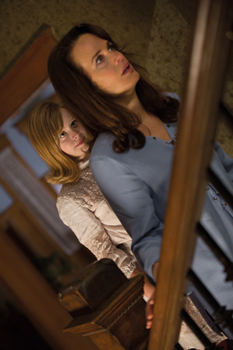
Kate Siegel Ouija Origin Of Evil
Cast: Kate Siegel, Henry Thomas, Doug Jones
Director: Mike Flanagan
Genre: Horror, Thriller
Rated: M
Running Time: 99 minutes
Synopsis: It was never just a game.
Inviting audiences again into the lore of the spirit board, this Halloween, Universal Pictures' Ouija: Origin of Evil"from Platinum Dunes and Blumhouse"tells a terrifying new tale as the follow-up to 2014's sleeper hit that opened at No. 1.
In 1967 Los Angeles, widowed mother Alice Zander (Elizabeth Reaser of the Twilight franchise) adds a new stunt to bolster her séance scam business and unwittingly invites authentic evil into her home. When the merciless spirit overtakes youngest daughter Doris (Lulu Wilson of Deliver Us from Evil), this small family confronts unthinkable fears to save her and send her possessor back to the other side.
A year and a half after her husband was killed, financially strapped Alice finds herself raising 15-year-old Paulina ('Lina") (Annalise Basso of Oculus) and 9-year-old Doris alone.
Fortunately for her struggling business, the occult runs in Alice's blood. Her mother was a fortuneteller and passed down the tricks of the trade, allowing Alice to put on an extravagant sideshow for clients who wish to speak with lost loved ones. The aspiring clairvoyant doesn't feel she's a fraud. Instead, she believes she's peddling closure"the elusive kind she prays to find for herself.
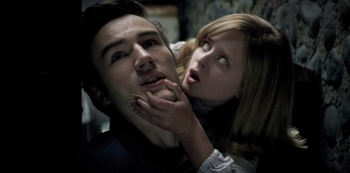 With mounting unpaid bills, Alice purchases a Ouija board to spice up her charade and rivet her customers. But once the game is brought into her home, strange things begin to happen: inexplicable noises, daily nightmares and, most disturbing of all, Doris actually starts communicating with the dead, including her father.
With mounting unpaid bills, Alice purchases a Ouija board to spice up her charade and rivet her customers. But once the game is brought into her home, strange things begin to happen: inexplicable noises, daily nightmares and, most disturbing of all, Doris actually starts communicating with the dead, including her father.
Initially, the revelations seems like a gift. Alice's business booms and clients find comfort connecting to those who have passed on, until the true history of the house is unearthed. Decades prior, a deranged surgeon performed grotesque experiments on mental patients under the same roof. Now, to make their screams of anguish heard, one of the tortured has taken possession of Doris.
The girls' school principal's, Father Tom (Henry Thomas of Gangs of New York), deep concern for Alice's family leads him to investigate the case. But when the four of them must face a supernatural power (Doug Jones of Pan's Labyrinth) for which even the priesthood could not prepare Tom, they will see that the spirits who've opened the portal have no intention of closing it without a deadly fight.
Ouija Origin Of Evil
About The Production
Origin of Ouija: Uncovering the History
The history of the Ouija board is just as mysterious as the game… Several different devices were introduced in the mid-1800s to communicate with those who had passed. Building on that fascination and momentum, entrepreneur Charles Kennard and attorney Elijah Bond formed the Kennard Novelty Company to produce and sell 'talking boards."
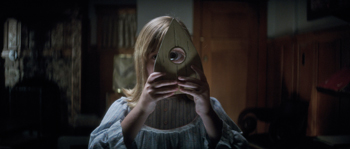 Legend has it that the company's founders asked the board what they should name it, and it spelled out 'O-U-I-J-A." When they asked what that word meant, the board spelled 'G-O-O-D L-U-C-K."
Legend has it that the company's founders asked the board what they should name it, and it spelled out 'O-U-I-J-A." When they asked what that word meant, the board spelled 'G-O-O-D L-U-C-K."
Charles Kennard and Elijah Bond left the company in the early 1900s, and William Fuld, one of the company's first employees and stockholders, took over and continued producing Ouija boards. The game's popularity continued to grow, so much so that by the 1920s Norman Rockwell featured a couple with an Ouija board on their knees on the cover of the Saturday Evening Post.
After Fuld's death in 1927, his children took over the game's production until 1966 when Fuld's estate sold the Ouija board assets to Parker Brothers, who began to manufacture the game as we know it today. In 1991, Hasbro acquired Parker Brothers and continues to bring the game to new generations of Ouija fans looking to experience the mystery of the talking board.
Exploding the Universe: Production Begins
When developing Ouija: Origin of Evil, Blumhouse Productions' Jason Blum and Platinum Dunes' Michael Bay, Brad Form and Andrew Fuller were excited to work with Hasbro Studios on the opportunity to expand dramatically the cryptic world of the mystical board. For this terrifying chapter that would explore the origin of evil in one small town, they would be trusting the franchise with a filmmaker known for work that is as innovative as it is heart-racing.
The production team approached visionary filmmaker Mike Flanagan, who created Blumhouse's 2014's hit Oculus and this year's hold-your-breath thriller Hush. They gauged his interest in crafting a chapter that delved into so much more of the legend of the board…as well as putting his unique stamp on the series.
Mike Flanagan felt it would be fascinating to explore the superstitious culture of the late 1960s' Ouija for this chapter, as well as what secrets laid buried beneath one family's home…only to be unlocked through the board. The horror maestro and his equally talented writing partner, Jeff Howard, imagined the tale of Doris and Lina Zander, who grow terrified the more they learn about the family home they share with their mother, Alice.
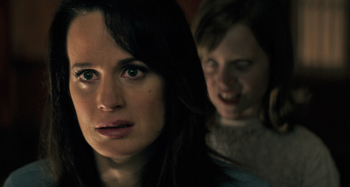 Jason Blum explains that when Alice begins using the Ouija board in her séances, she thinks it's great for business. He notes: 'In the beginning, Alice is not discovering anything evil, and it actually seems like it's a great thing. She thinks that she's performing this amazing service where"if you have someone in your life who's gone"you can come use the Ouija board and connect with them. Through Doris you can talk to people who are no longer with us in this world. Initially it seems like it's not only good for business, but good for people too."
Jason Blum explains that when Alice begins using the Ouija board in her séances, she thinks it's great for business. He notes: 'In the beginning, Alice is not discovering anything evil, and it actually seems like it's a great thing. She thinks that she's performing this amazing service where"if you have someone in your life who's gone"you can come use the Ouija board and connect with them. Through Doris you can talk to people who are no longer with us in this world. Initially it seems like it's not only good for business, but good for people too."
'There was a lot of discussion about making a direct sequel to the first film and expanding upon that narrative," explains Brad Form, 'but that felt like the easy answer. When we took a hard look at the source material, we began to see that the story was right in front of us. Who was the real -DZ' who was haunting our characters in the first movie, and what had been done to her so long ago that turned her into the twisted spirit seeking out revenge upon anyone who inhabited her home?"
Andrew Fuller, who serves as Michael Bay and Brad Form's production partner at Platinum Dunes, shares how the film's dramatic themes appeal to a broad base of moviegoers, and that it was of utmost importance to all involved to make this a story about a broken family…and not just a ghost story. 'If you strip away the supernatural elements, you'll find a family going through something extremely tragic and then extremely frightening," he says. 'Audiences who wouldn't necessarily seek out a horror film will connect to this character-driven story."
To do that, filmmakers delved into the creation of the first movie's evil. 'I would love a movie about Samara before she was a wicked creature crawling out of the well in The Ring," says Mike Flanagan. 'For me, the journey between those two points is fascinating and rarely explored in horror films."
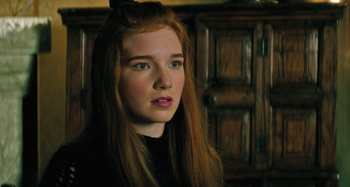 So notes Brad Form, a thriller centered on a Ouija board made the perfect vehicle for relatable horror. 'The idea that we could wrap a film around this intense desire to contact those on the other side was irresistible, and Ouija boards are so specific to that," he explains. 'Even people who don't believe in spirits have such a strong reaction to the game. This game has the power to turn non-believers into believers, even if only for a moment."
So notes Brad Form, a thriller centered on a Ouija board made the perfect vehicle for relatable horror. 'The idea that we could wrap a film around this intense desire to contact those on the other side was irresistible, and Ouija boards are so specific to that," he explains. 'Even people who don't believe in spirits have such a strong reaction to the game. This game has the power to turn non-believers into believers, even if only for a moment." Jason Blum speaks for the team when he advises that Mike Flanagan was the perfect director to helm a project that worked so well within Blumhouse's micro-budget model. 'Mike Flanagan is that rare combination of someone with a strong point of view and vision, but he's also able to take notes and curve balls better than almost anyone I've ever worked with. When you're doing extreme characters in an extreme story, you have to trust the person in charge because it can be a fine line between scary and funny. In Mike Flanagan's hands, you are absolutely on the safe side of being scary and you're working within a deeper, layered story."
To craft a character-driven thriller, Mike Flanagan and Charles Howard first approached the script as period drama about a single mother and her daughters. 'For the first 45 minutes, The Exorcist is a drama; there's nothing supernatural. The film connects you to the characters and allows you to relate to their reality, so when the horror happens, it grabs people by the throat," says Mike Flanagan. 'I was thrilled to create a story around a family whose lives and business are built around contacting the dead, because I found that dynamic so fascinating."
To continue to challenge the expectations of seasoned fans of horror, the writing duo played with the genre's more predictable rhythms. 'If audiences hear three seconds of silence after a line, they're already anticipating the jump scare," notes Mike Flanagan. 'They already know when the beat hits, so it's imperative to find the unexpected. The scares in this film feel more spontaneous, like jazz."
One ubiquitous element the thriller required was a priest. Andrew Fuller explains Father Tom's presence: 'Roger Ebert once wrote that if you're dealing with demonic possession, you need a Catholic priest"no other faith seems to cut it."
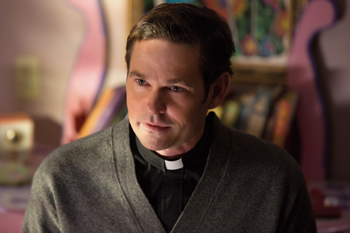 The writers put a spin on the familiar trope by making Father Tom charming and attractive, so that he could serve as a theoretical love interest for Alice. 'One of my favorite scenes shows Alice and Father Tom out to dinner, and Lina and her crush Mikey [Parker Mack] in her bedroom. We cut between a teen girl's first kiss to two adults who share a spark, but life has taken them on different paths," states Jason Blum. 'It's juxtaposing the possibility of young love with an adult relationship that takes the realities of life into account."
The writers put a spin on the familiar trope by making Father Tom charming and attractive, so that he could serve as a theoretical love interest for Alice. 'One of my favorite scenes shows Alice and Father Tom out to dinner, and Lina and her crush Mikey [Parker Mack] in her bedroom. We cut between a teen girl's first kiss to two adults who share a spark, but life has taken them on different paths," states Jason Blum. 'It's juxtaposing the possibility of young love with an adult relationship that takes the realities of life into account." In fact, Father Tom's character is based on a priest Flanagan knew during his 12 years as an altar boy. The director explains: 'Father Stack had an empathy for people I believed was only possible if you had lived an intense life prior to the priesthood. I later learned he was engaged to a woman and always wondered about his massive change of trajectory."
Art imitating life, the film reveals Father Tom's wife died long ago, and his tragic loss was the impetus that led to the priesthood. Suspicious of Doris' 'gifts," Tom asks her to contact his wife through the Ouija board and discovers the evil game that the spirits are playing on the Zander family.
To convince Alice of the deception, he quotes John, Chapter Four: Verse One: 'Do not believe every spirit, but test the spirits to see whether they are from God, for many false prophets have gone out into the world."
By the time Alice sees the darkness that has taken over Doris, however, it might be too late for anyone who steps foot in their house…
Never Play Alone: Casting the Supernatural Thriller
When casting Ouija: Origin of Evil, Flanagan and his producers sought actors whose performances could add depth to the film's complex family drama while grounding the elements of horror in reality.
First, filmmakers turned to Elizabeth Reaser, known worldwide for her work in the Twilight series, to play smart and resourceful single mother Alice Zander. Mike Flanagan explains that he's been familiar with the performer's work for some time: 'I first saw her in this great movie called Sweet Land that was at some festivals with short film that I'd made long ago. She was just radiant in it, and she brings a sense of warmth and empathy with her everywhere she goes. What I am fascinated most with in Elizabeth is that her eyes project everything that's happening in her mind and in her heart. She's one of the most open actresses I've ever seen."
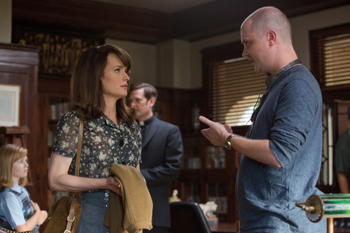 For her part, Elizabeth Reaser embraced the challenges that would lie ahead: 'What really spoke to me about this movie is how it explores grief and that strong desire to see or talk to someone we've lost, even just once more," says Elizabeth Reaser. 'In many ways, this film isn't simply a horror movie, which is what makes it so terrifying. These characters don't know what is happening to them because they're already dealing with a loss so devastating…they can't fathom life could get worse."
For her part, Elizabeth Reaser embraced the challenges that would lie ahead: 'What really spoke to me about this movie is how it explores grief and that strong desire to see or talk to someone we've lost, even just once more," says Elizabeth Reaser. 'In many ways, this film isn't simply a horror movie, which is what makes it so terrifying. These characters don't know what is happening to them because they're already dealing with a loss so devastating…they can't fathom life could get worse." While Alice actively tricks people to make a living she believes she's legitimately giving them a sense of comfort she's lacking. She secretly hopes one day she'll be able to contact her husband, unknowingly priming herself to be fooled by spirits with a dark agenda.
'She's so blinded by grief that I think this is the only time she's vulnerable enough to be tricked by these spirits," says Elizabeth Reaser. 'One of the tragedies of this film is that these horrific things happen because Alice so desperately wants to believe in what she pretends to do. Grief, loss, love, family"anything that's truly a matter of the heart can eclipse our better judgment, and I for one can relate to that."
Alice has a love interest in the form of Father Tom. 'I wanted the trope of a Catholic priest, but I wanted to put an unfamiliar spin on it," says Mike Flanagan. 'Alice and Father Tom have a forbidden attraction that can never be realised because their lives have already taken them on such divergent paths."
For his part, Father Tom becomes increasingly suspicious of Doris's 'gift." Ultimately, his concern for Alice and her family leads him down a spiritually dangerous path. When it came to casting the character, filmmakers turned to two-time Golden Globe Award-nominated performer Henry Thomas, who began his career in the beloved blockbuster E.T. the Extra-Terrestrial and has gone on to star in films such as Gangs of New York. 'I've been a fan of Henry's as long as I've been a fan of movies," says Mike Flanagan. 'Once his name came up, I couldn't imagine another actor playing the part."
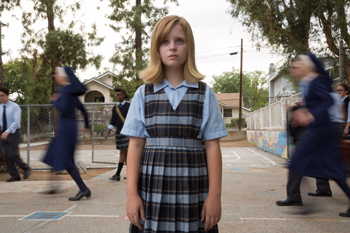 enry Thomas appreciated how the story of the Zander family played against type. 'During my initial meeting with Mike, he told me that in this genre, we have to destroy all these characters"it's just way it goes," Henry Thomas recalls. 'But he didn't want to make the mistake of not having the audience invested first."
enry Thomas appreciated how the story of the Zander family played against type. 'During my initial meeting with Mike, he told me that in this genre, we have to destroy all these characters"it's just way it goes," Henry Thomas recalls. 'But he didn't want to make the mistake of not having the audience invested first." Ouija: Origin of Evil dedicates much of its first two acts to developing the characters and their complex relationships. 'Everybody knows what's coming at a certain point," says Henry Thomas. 'My goal as an actor was to suspend that moment and play with it so much that the audience forgets the foregone conclusion by the third act, which is mostly just brutal destruction."
Henry Thomas explains how Mike Flanagan serving as the film's director and editor led to efficiency on set: 'The best directors I've worked with always know exactly what they need from the scene in terms of shots and performance. Mike explains his vision very simply and elegantly. Ultimately, he knows what he needs to cut together, and this allows actors creativity without doing anything unnecessary."
Next up, filmmakers went in search of the source of so much of Father Tom's consternation: Doris. They knew the role they knew would be the most difficult to cast. 'The script asks a lot from someone so young, so we auditioned countless actresses," states Mike Flanagan.
Young horror veteran Lulu Wilson, who had shown her chops in Deliver Us from Evil, was able to perfectly balance the innocence and evil of Doris. Recalls the director: 'She prepared a monologue from the film where she explains in disturbing detail what it's like to be strangled to death, and I almost fell off my chair. She was the only actress who didn't deliver the dialogue in a frightening way. Instead, she delivered it casually, innocently and with a smile, which was such a sophisticated choice."
When it came to her stunts, led by the talented stunt coordinator Mark Rayner, the actress also performed well beyond her years. 'There's a scene where Doris scales a wall, and we wanted Lulu instead of using one of Lulu's stunt double in a wig," recalls Mike Flanagan. 'She was fearless; the first time I saw her up the wall with a huge grin on her face, it was incredible."
Adds Luly Wilson, who remains in staunch admiration of her stunt doubles on set" Emily Brobst and Juliana Potter"'It was crazy, and I was a little nervous but not too much."
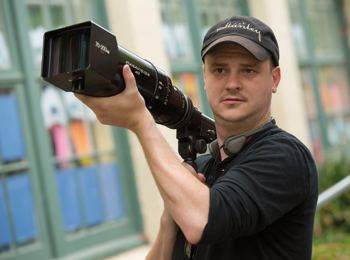 While horror films are off limits for 10-year-old, she hopes her parents make an exception for Ouija: Origin of Evil. 'I won't let them get away without letting me watch it," Wilson states determinedly.
While horror films are off limits for 10-year-old, she hopes her parents make an exception for Ouija: Origin of Evil. 'I won't let them get away without letting me watch it," Wilson states determinedly. Mike Flanagan penned the part of Doris' older sister, the intelligent, strong-willed Lina, with Basso in mind. 'I first worked with Annalise when she was just 13, and I thought she was one of the finest actors I'd ever met," he says. 'I knew she was perfect for this part."
Basso was equally thrilled to team up with her Oculus filmmaker once again. 'As a director, he gives you a specific vision and the freedom to interpret that vision," commends Basso. 'He always asks, -Do you want one more take?' He's so kind and aware of what you as a performer need on set."
Lina's layered character appealed to 16-year-old Basso. 'We're almost the same age, so I related to her struggle to find her own identity," says the actress. 'Lina is reckless, and I like that about her. I also admire her strength, which she learned after her father's death, and how she uses those two qualities to stand up to her mother and the powerful spirits inside the house."
Basso was also drawn to Lina's love story with Mikey, a senior who's interested in the sophomore for all the right reasons. 'There's a pure and wholesome connection between these two teenagers, which is a relationship you rarely see in horror movies," says Basso. 'They have a very sweet romance, but it's complicated. She's just starting to feel the first pangs of young love, while experiencing the consequences of losing someone you care for so much."
Finally, filmmakers sought out veteran creature actor Doug Jones to portray the film's evil entities. Doug Jones"the beloved movement artist who has played fascinating characters in Guillermo del Toro's films such as Abe Sapien and the Angel of Death in the Hellboy series, as well as Pan and Pale Man in Pan's Labyrinth"was excited to work with Mike Flanagan. 'Mike excels at getting the relationships and family dynamics down in a way that we're learning something and growing from it," says Doug Jones. 'Guillermo del Toro is much the same; he does dark things that have meaning and purpose."
Mike Flanagan explains that they have a long history together: 'I first had the privilege of working with Doug Jones back in 2010 on a tiny little independent movie that I was shooting in my apartment called Absentia. The appearances of the creatures in this film are so spread out and brief, we needed an actor who could maximize the amount of impact. Audiences might see Doug Jones for a few seconds on screen, but will not be able to forget his image."
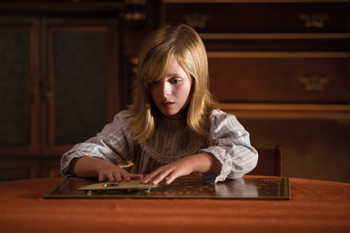 orror Comes Home: Design, Location and Costumes
orror Comes Home: Design, Location and Costumes The production team knew that in order to give the supernatural thriller the perfect late-1960s look and feel, costume, location and production design would be critical. This would allow them the creation of an authentic atmosphere or the film that would be truly transportive for viewers.
Production Design
From the Zander home's wallpaper to its candlewicks, production designer Patricio Farrell ensured every detail in the story's environment was period accurate. 'Patricio's attention to detail was astonishing," lauds Mike Flanagan.
Through extensive research, Patricio Farrell immersed himself in the world of the script to establish a visual foundation. Instead of limiting set pieces to what was shiny and new in 1967, Farrell decided to embrace a time before the 1960s, specifically Art Nouveau, to capture the essence of this family and the wicked history of the house.
'Using this style as a sub-current, we could define the aesthetics of the world, and reserve splashes of color and splashes of the rebellious '60s in precise places, where it would also help the story," explains Patricio Farrell, who previously collaborated with Mike Flanagan on Before I Wake. 'Not restricting ourselves to just the 1960s helped with the challenges of affordability and availability, and allowed us to imbue the film with a richer layer of textures that takes us back to more idyllic and safer times."
Patricio Farrell and Mike Flanagan agreed they wanted the Zander home to look warm and lived in…so the horrific elements that evolve would stand out even more. 'My intention for the film was to make the most beautiful sets I could," Patricio Farrell says. 'It's certainly less expected, even more perturbing to see something inexplicable and terrifying in a familiar setting. It's harder to forget when horror comes home. Ultimately, to help create a scary or suspenseful scene, within a beautiful environment, requires a great story. That's what Mike brings to his projects."
Location
The 19th-century craftsman"where much of the film was shot in Los Angeles"had to accommodate Ouija's stunts, which proved a unique challenge. 'We had characters flying through the air, flying up against walls, flying up and down stairs, dangling in the front foyer, and we had to do that in the actual space," says Mike Flanagan. 'Accommodating the complicated stunt rigging and capturing these stunts in a dynamic way was an incredibly challenging puzzle to solve. If an actor or stunt double missed a physical mark by just a couple of inches, the whole scene would fall apart."
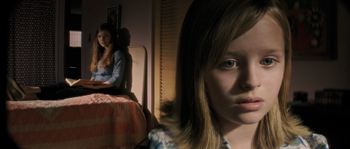 In the filmmakers' continued quest for authenticity, Basso and Wilson took the opportunity to give the stunt work a try. 'Young actors have so much fun doing stunts, and we wanted to give Annalise and Lulu the opportunity to perform as many of their own as possible, within reason of course," says Mike Flanagan. 'Watching them scale walls and swing through the foyer of the house was pretty harrowing, and they absolutely nailed it."
In the filmmakers' continued quest for authenticity, Basso and Wilson took the opportunity to give the stunt work a try. 'Young actors have so much fun doing stunts, and we wanted to give Annalise and Lulu the opportunity to perform as many of their own as possible, within reason of course," says Mike Flanagan. 'Watching them scale walls and swing through the foyer of the house was pretty harrowing, and they absolutely nailed it." While certain spaces made for tricky shooting arrangements, the century-old home's open floor plan"with its wide doors and spacious staircases"allowed for stunning cinematography work from DP Michael Fimognari. 'The house is full of history and texture, and since the film spends so much time there, the home serves as another character in the film," says Brad Form. 'The dark, meandering rooms create a beautiful but strange feel, which translates to the screen. People have a natural fear of old homes and the history hidden within the walls. It's like Mikey says, -this house certainly has good bones.'"
Costumes
To ensure wardrobe was also period-appropriate, costume designer Lynn Falconer heavily researched the silhouettes and fabrics that were quite popular during 1967. 'Instead of using costume houses, I sourced as much of the clothing as I could from estate sales around Los Angeles," Falconer shares. 'I needed to climb into a lot of closets that were out of the way to find pieces that hadn't already appeared on shows like Mad Men."
Still, she felt a stiff, more buttoned-up business look didn't suit Alice. 'As a fortuneteller, her character seemed more progressive, and I wanted that feeling reflected in her wardrobe. I opted for fashions from the late 1960s, when style started to relax a bit," explains Falconer. As well, the widow is just starting to come out of her shell, after the devastating loss of her husband a few years prior. 'As a character, Alice is a combination of soft and sturdy, and that's reflected in her softer tops paired with a tailored skirt."
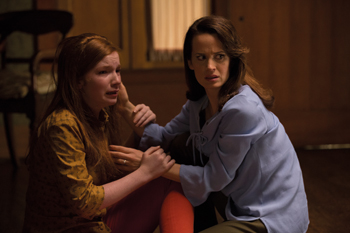 For Lina, Falconer opted for a 1960s style icon. 'My inspiration was Twiggy in her off-camera moments, which were all about mini-skirts and cute, little sweaters," says the costumer. 'Annalise has this amazing head of red hair, so colors like purples, browns and rusts that were popular at the time worked perfectly."
For Lina, Falconer opted for a 1960s style icon. 'My inspiration was Twiggy in her off-camera moments, which were all about mini-skirts and cute, little sweaters," says the costumer. 'Annalise has this amazing head of red hair, so colors like purples, browns and rusts that were popular at the time worked perfectly." Falconer channeled her childhood to dress Doris. 'I was about her age in 1967, and I pulled from what I remember wearing as a girl, including crocheted vests," she offers. 'When Doris turns ghostly, we had to find a white dress similar to the one from the fist Ouija film. The challenge was to find a new piece that was also '60s-inspired so we could buy multiples. As well, the dress had to be made of a fabric that could accommodate the stunt work."
Naturally, the color palette from The Exorcist helped inform Father Tom's wardrobe. 'Our film was much richer in terms of color, and even though we didn't have much leeway with a priest's wardrobe, I wanted the costume to reflect that," explains Falconer.
To complete the look, Falconer again pulled inspiration from her childhood. 'During my time as a Catholic school girl in California I knew Father Rick, a young priest whose sermons I actually listened to," she laughs. 'I created a similar wardrobe for Father Tom that played up his youthfulness."
Ouija Origin Of Evil
Release Date: October 20th, 2016
MORE
- Mission: Impossible Fallout
- Glenn Close The Wife
- Allison Chhorn Stanley's Mouth Interview
- Benicio Del Toro Sicario: Day of the Soldado
- Dame Judi Dench Tea With The Dames
- Sandra Bullock Ocean's 8
- Chris Pratt Jurassic World: Fallen Kingdom
- Claudia Sangiorgi Dalimore and Michelle Grace...
- Rachel McAdams Disobedience Interview
- Sebastián Lelio and Alessandro Nivola...
- Perri Cummings Trench Interview



